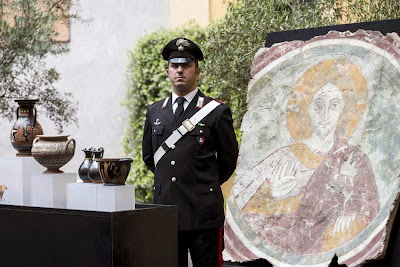Peter Watson explored the relationship between Giacomo Medici and Nikolas Koutoulakis. Koutoulakis' name also appears in the 'organigram'. So would a potential buyer be nervous if a Greek object was on offer with its stated collecting history ("provenance") as 'from the Koutoulakis collection'?
Discussion of the archaeological ethics surrounding the collecting of antiquities and archaeological material.
Thursday, 11 June 2015
Wednesday, 10 June 2015
The Koutoulakis Herm returns to Greece
 |
| Source: Hellenic Ministry of Culture |
The head has now been returned to Athens and features in a major press release. Sadly Tsirogiannis' contribution is not acknowledged.
I have written on the issues relating to this herm in the Journal of Art Crime ("Context Matters: Learning from the Herm: The Need for More Rigorous Due Diligence Searches").
This case reminds us of the need to authenticate the documentation used to present collecting histories, and it brings into question the issues relating the due diligence search conducted by Bonhams (and its agents).
It perhaps shows that objects associated with Koutoulakis are not above suspicion. I was recently viewing such an object linked with that individual in a high profile London gallery. What questions should be asked about that piece?
For my earlier discussion of this herm see here.
Monday, 8 June 2015
Journal of Art Crime 2015 (Spring)
The Spring number of the Journal of Art Crime, edited by Noah Charney, is now available.
Here is the table of contents for the latest issue of this bi-annual publication listing the archaeological papers that will be of interest to readers of LM:
ACADEMIC ARTICLES
REGULAR COLUMNS
EDITORIAL ESSAYS
REVIEWS
Here is the table of contents for the latest issue of this bi-annual publication listing the archaeological papers that will be of interest to readers of LM:
ACADEMIC ARTICLES
- Analyzing Criminality in the Market for Ancient Near Eastern Art by Ryan Casey
- Damaging the Archaeological Record: The Lenborough Hoard by David Gill
- “But We Didn’t Steal It:” Collectors’ Justifications for Purchasing Looted Antiquities by Erin L. Thompson
REGULAR COLUMNS
- Context Matters “From Palmyra to Mayfair: The Movement of Antiquities from Syria and Northern Iraq” by David Gill
- Nekyia “Duplicates and the Antiquities Market” by Christos Tsirogiannis
EDITORIAL ESSAYS
- New Archaeological Discoveries and Cultural Ventures beyond War Threats: A Model of Excellence Stemming from Iraqi-Italian Cooperation by Francesca Coccolo
REVIEWS
- Cultural Heritage Ethics: Between Theory and Practice Edited by Constantine Sandis Reviewed by Marc Balcells
Thursday, 4 June 2015
From an old Montecito collection
When a Palmyrene sculpture appears on the market you would expect the auction house to provide an authenticated collecting history. "Acquired prior to 1996" sounds rather imprecise and suggests that there is no documented collecting history showing the sculpture's origins.
Wednesday, 3 June 2015
The impact of the Medici and Becchina archives
 |
| Source: MiBACT |
It is clear that in spite of the 1970 UNESCO Convention auction houses, galleries and dealers continued to handle recently surfaced material from Italy, and that public museums (including university collections) and private collectors continued to acquire this material without asking serious questions about how the material arrived on the market.
Christopher Chippindale and I explored some of the themes in 2000 [see JSTOR] without access to the photographic archives. We were able to identify pieces without a collecting history that could be traced back to the period before 1970 that were subsequently returned to Italy.
Peter Watson's investigations into a major auction-house in London identified the way that objects were consigned to the market, and these sales have been represented by a number of objects that have been returned.
So why are dealers and museum directors calling for these photographic archives to be made public? First, they do not wish the lack of due diligence in the preparations for sales and acquisitions to be made public. Second, there is concern that there could be reputational damage if objects are identified in collections are sales.
So what can the market do? There needs to be an improvement in the due diligence process, and objects need to be provided with properly authenticated and documented collecting histories. Is that too much to ask?
Subscribe to:
Comments (Atom)
Two lots withdrawn from Bonham's sale
Becchina Archive Source: Christos Tsirogiannis. Dr Christos Tsirogiannis has identified two lots that were due to be auctioned at next week...

-
Source: Sotheby's A marble head of Alexander the Great has been seized in New York (reported in " Judge Orders Return of Ancien...
-
Tarentine funerary relief Source: Metropolitan Museum of Art The Manhattan DA has provided limited details about the recent return of antiqu...
-
If international museums can no longer "own" antiquities either through purchase on the antiquities market or through partage , wh...


